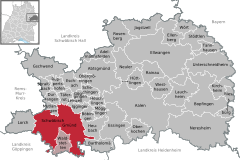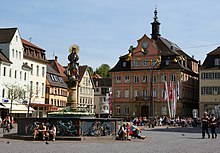Schwäbisch Gmünd
Schwäbisch Gmünd is situated within the northern foothills of the Swabian Jura Mountains on the Rems river, about 50 kilometres (31 miles) east of the state capital Stuttgart.
The municipal area comprises the localities (Ortschaften) of Bargau, Bettringen, Degenfeld, Großdeinbach, Herlikofen, Hussenhofen, Lindach, Rechberg, Rehnenhof-Wetzgau, Straßdorf, and Weiler.
The Romans built the Limes Germanicus to secure this border; i.e., a line of fortifications at regular distances, which included a small castrum on the site of the present-day Schirenhof field in Schwäbisch Gmünd.
A first major settlement in this area arose around the 2nd century AD, when Roman soldiers were deployed near the Upper Germanic limes.
Gmünd was first mentioned in an 1162 deed issued at nearby Lorch Abbey, then under the rule of the Hohenstaufen emperor Frederick Barbarossa.
The demesne officer, wine expert and archaeologist Carl Gok [de] (1776–1849), a half brother of the poet Friedrich Hölderlin, suspected in 1847, that the alleged castle on the Schirenhof manor had probably once been a Roman fort.
On some of the last days of May 2016, a major storm that hit parts of France and southwestern Germany resulted in extensive flooding and damage to Schwäbisch Gmünd and the death of two people in the city.
Both the initial construction of the building and the conversion of the Debler patrician house into the city hall were undertaken by Johann Michael Keller.
Initial construction began around 1325 under the leadership of an unknown master builder on what was left of the previous romanesque church, the towers of which were still standing.
[8] One of the oldest universities in the city is the Hochschule für Gestaltung Schwäbisch Gmünd, a design school established in 1776.
EAST grants annually the Schwäbisch Gmünd Prize for young scientists since 2017, in honor to the local tradition of craftsmanship of precious metals.
It enchants the audience with artists from all over the world and offers open workshops and a visit to the interactive museum.
Today it is known as Silver overlay and Schwäbisch Gmünd was home of inventor Friedrich Deusch who began to decorate not only porcelain but also glass with this unique technique in the end of 19th century.
The city is also home to the Forschungsinstitut für Edelmetalle und Metallchemie, an institute for precious metal work and surface technology.
Other important industries include automotive suppliers like the steering division of Robert Bosch GmbH, manufacturers of machinery and glass, and a large subsidiary of the Swiss toiletries and medicine producer Weleda.












